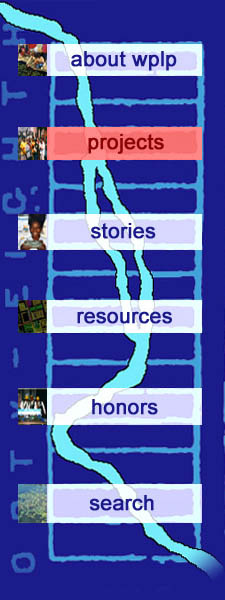Mill Creek Project:
WPLP-Sulzberger Middle School Partnership Since 1995
| Our goal is to explore how a new
curriculum organized around "The Urban Watershed"
can combine learning, community development, and water resource
management. The whole neighborhood is the classroom with the
school at the center. At the heart of the story is the Mill
Creek, a stream that once flowed across the field where the
school playground is now, and still does flow, buried in a
sewer that runs right past the school. Together, from 1996-2001,
Penn and Sulzberger students learned to read the neighborhood's
landscape, to trace its past, understand its present, and
envision its future. The tools they used were their own eyes
and imagination, the place itself, and primary documents -- old
maps, photographs, tax records, census tables, railroad timetables,
city plans -- windows into otherwise hidden dimensions. Field
trips and classroom guests from the Philadelphia Water Department,
the West Philadelphia Empowerment Zone, and Aspen Farm Community
Garden enriched the learning experience. Ideas were expressed
through discussions, writing and drawings. The students shared
their own neighborhood stories by making posters, newsletters,
booklets, and web sites.
|
Spring 2002
|
| In spring 2002, MIT students in
"Media Technology and City Design and Development,"
taught by Spirn and Ceasar McDowell, redesigned the WPLP
website. As part of this project, they visited the Mill Creek
neighborhood and met with students in Sulzberger teacher Donald
Armstead's after-school
computer program. |
 |
Spring to Summer 2001
|
In summer 2001, the Philadelphia Water Department organized a
watershed summer program with Sulzberger teachers. As part of
this program, Sulzberger students helped design and build a
demonstration project, The Watershed, on a vacant lot across
the street from the school.
|
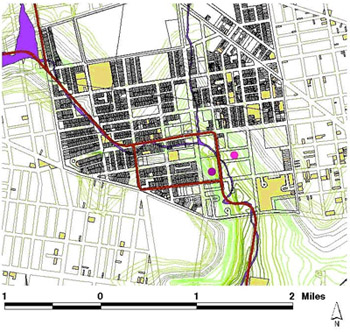 |
In spring 2001, MIT students in architecture and civil and
environmental engineering designed a wetland/water garden on
a vacant lot near Sulzberger as part of Spirn's course in
"Media
Technology and City Design and Development." The
course included a field trip to Philadelphia and a meeting
with students in Sulzberger teacher Donald Armstead's after-
school computer program. Students in three seventh and eighth
grade classes also worked with Spirn's Penn students in
"Power of Place: Introduction to Urban Environmental
Design." Together they learned about the history of
the neighborhood and made proposals for new landmarks that tell
stories of Mill Creek's past, present, and future. |
Fall 99 to Spring 2000
Summer 99
| The fish pond, wetland,
and outdoor classroom for environmental study at Aspen
Farms community garden was expanded and reconstructed.
The revised design reflected the urban wetland curriculum for seventh-
and eighth-grade science devised in summer 1998 for use
in a constructed wetland near the school. The facility
was completed with support from the Philadelphia Urban
Resources Partnership and Philadelphia Green. |
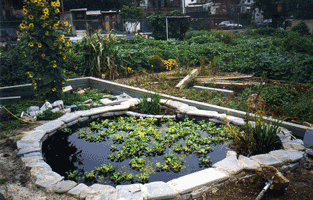 |
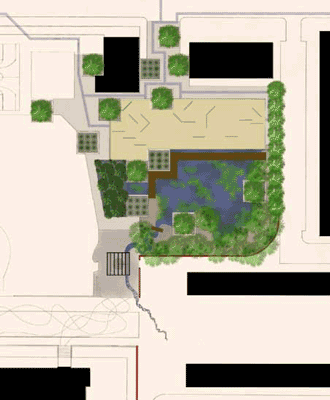 |
Primary documents and other curriculum
materials developed and used in SMS classrooms over the
last three years were reorganized. The product is a set
of curriculum materials about the social, environmental,
and architectural history of Mill Creek and West
Philadelphia, which combine primary documents (maps,
prints, photographs, tax and census records, planning
reports, newspaper articles) matched to sets of questions
designed to provoke critical thinking, elicit a line of
reasoning, yield insight into the processes shaping the
neighborhood, and inspire ideas for community design,
planning, and development. These materials will enable
SMS teachers to use this information more effectively;
they are appropriate for use with youth or adults. |
Spring 99
 

|
In spring 1999, sixty-four students in
Ms. Hoxter's and Mr. Mells seventh and eighth grade
classes worked with eleven Penn students in Urban
Studies 205: "Power of Place: Introduction to
Urban Environmental Design." Together they read the
history of the neighborhood in the urban landscape and
its streets, buildings, vacant lots, topography, plants,
soil, and rocks. Penn and SMS students made proposals for
new landmarks that tell stories of Mill Creek's past,
present, and future. Mill Creek is one of several
neighborhoods city-wide selected to work with an artist
to develop proposals as part of the Fairmount Park Art
Association's New Landmarks Program. The students work
contributed to that project. |
Fall 98
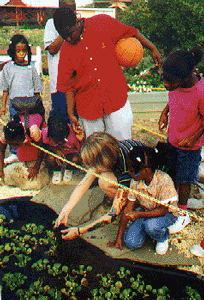 |
In November
1998, the Philadelphia School District named Sulzberger
Middle School "School
of the Month" for its pioneering curriculum and
service learning initiative. Professor Spirn was also
honored as the School District's "Person of the
Month" for her four years work at Sulzberger.
In Fall 1998, nine students from Professor Spirn's Transforming
the Urban Landscape studio started the semester by
designing an expansion of the water garden/outdoor
classroom at Aspen Farm and went on to design a
wetland/water garden/outdoor classroom for a vacant lot
next to Sulzberger. The Penn students spent eight
afternoons with 64 students in Ms. Hoxter's and Mr. Mells
seventh and eighth grade classes to develop ideas for the
environmental study area and an associated curriculum.
Together, they dissected and analyzed flowers and looked
at them under a microscope, studied water flow and water
quality, designed water catching apparatus and many other
activities. The Sulzberger students also reviewed and
critiqued the Penn students' designs for Aspen Farm.
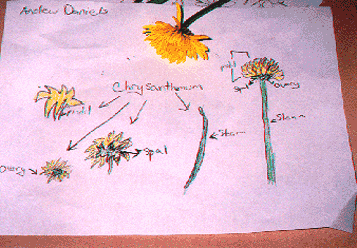
|
 |
Summer 98
 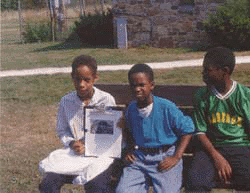
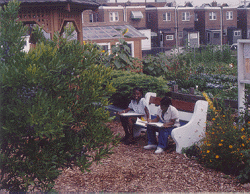

|
Summer
Program '98 In the Summer of 1998, the SMS / PENN
Summer Program returned for its second year. The program
increased in size from 12 students during the summer of
'97 to about fifty students. Its main purpose was to
provide a strong base for the new Environment Small
Learning Community which will begin in Fall of 1998.
Children attending the program studied a variety of
subjects led by West Philadelphia Landscape Project staff
and Sulzberger teachers. The SMS teachers involved were
Glenn Campbell, Barbara Wells, Larry Jones, Donald
Armstead, Crystale Roye, and Erika Stewart. The WPLP
staff were Sam Spirn, Danielle Floyd, Kevin Smith, and
Kamni Gill. The National School and Community Corps also
helped out, and were designated as team leaders for the
five different groups of students. They were led by
Warren Bell.
The Sulzberger students split the
three hour morning between two out of the six subjects -
Computers, Conflict Resolution, Aspen Farm Garden, Mill
Creek History, Entrepreneur, and Wetlands. In the
computer class, the kids learned basic skills in
Netscape, Adobe Photoshop, and Microsoft Word. The
Conflict Resolution class taught the kids productive ways
to solve conflicts, and was also used as a forum to
discuss problems at home. At the Aspen Farm Garden, under
the supervision of Hayward Ford, the children from the
summer program helped weed, painted fences and clean up
the garden. The Mill Creek history section focused on a
brief history of the neighborhood, and in the
Entrepreneurial section, students learned how to form a
business plan. In the Wetlands section, students studied
animals and plants which live in wetlands, built models
with clay, and visited the John Heinz Refuge.
|
Spring 98
Fall 97
Summer 97
 

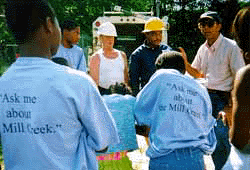
|
Ask
me about the Mill Creek. In the summer of
1997, four Sulzberger teachers, two Penn students, Martin
Knox and Yu-Ting Lee, and a dozen Sulzberger students
continued to develop the Mill Creek Watershed curriculum
during a four week long session. The teachers were
Barabara Wells, Donald Armstead, Larry Jones and Glenn
Campbell. Mr. Campbell was already familiar with the
urban watershed themes from the previous school year.
Martin and Yu-Ting were previously in Professor Spirn's
Fall 1996 "Transforming the Urban
Landscape"studio.
Outdoor activities included regular
visits to the nearby Aspen Farms Community Garden. There
were several construction projects built to serve as an
outdoor classroom for a year-round environmental studies
program. The projects included installing a small
hardshell pond with aquatic plants, a butterfly house at
the butterfly garden, and a vegetable plot with a compost
bin. (See
Sulzberger students' webpage reports.) Hayward Ford,
President of Aspen Farms and Jeff Myers of the
Pennsylvania Horticulture Society also assisted the
students. Many students brought their families to the
garden for the first time.
Indoor activities included making a topographical
model of the watershed, mapping watersheds, (worksheet) and webpage
reports (see Summer Programs).
The group discussed the value of trees in the city and
designed a street tree nursery for their school grounds
after a visit from Mindy Maslin of Philadelphia Green.(worksheet) As an
exercise in reclaiming vacant land, the group designed
proposals for a miniature golf course near their school.
Each hole is an illustration of an era in the Mill
Creek's history. (worksheet)
They went on a field trip to a miniature golf course with
an international theme in Rosyln, PA. (worksheet)
|
| On the last day of the program, the group made a bus
trip that traced the Mill Creek from the school to the
Schuylkill River and met Joe Serrone from the
Philadelphia Water Department. They also visited
Bartram's Garden near the Schuylkill River to view a
wetland reclamation project that probably resembles the
historic mouth of the Mill Creek. |
Spring 97
Power
of Place:
Water, Schools, and History In spring 1997,
thirty Sulzberger students in Glenn Campbell's eighth
grade class worked with Professor Spirn and five Penn
students of Urban Studies 320: "Power of Place:
Water, Schools, and History." The Penn students
shared their reports and primary reference sources
addressing the following topics:
- Pre-Colonial, Colonial and Early Industrial.
- Census Data; 1860-1990.
- Transportation, Land Development and Water
Management: 1880-1940.
- Urban Redevelopment and the Mill Creek
Neighborhood:1930-1975.
- Mill Creek in the Edge City Period: Late 1970's -
Present.
Special classroom guests included:
Deborah Napper,
West Philadelphia Empowerment Zone;
Rodnie Jamison,
Philadelphia City Planning Commission;
Hayward Ford, President of
Aspen Farms
Community Garden
|
|
 
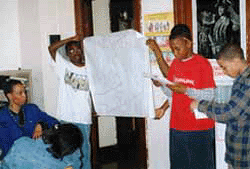
|
|
| The Sulzberger students gave a public presentation
with slides and posters at a symposium held at the
University of Pennsylvania in May. The posters were also
showcased in June at the Philadelphia Urban Resources
Partnerships Conference at the Philadelphia Convention
Center. Before the students graduated, Penn students made
a booklet of the Sulzberger students drawings and essays
regarding the Mill Creek history and plans for a water
garden. |
 |
Excerpt from Sulzberger
teacher Glenn Campbell's booklet foreword: "
As they shared knowledge and research methods, both
groups of students used cultural exploration to shatter
cultural and academic myths and create a powerful
partnership across secondary school and university
levels."
|
Sim-City
Competition
'Silver City' During the winter of
1996 the students of Daisy Century's science class
participated in the 5th annual National Engineers Week
Future City Competition. Since the program began in 1992,
the purpose of the competition has been to introduce
students to engineering through practical applications of
math and science and work with engineers.
The team consisted of three Sulzberger students, a
licensed civil engineer and Martin Knox, a Penn landscape
architecture student. They designed future cities on a
computer using Maxis' SimCity Classic) software and used
a blueprint to build a model of a section of the created
city.
"Silver City" won Best Design at the
Philadelphia region competition held at the Franklin
Science Institute.
|
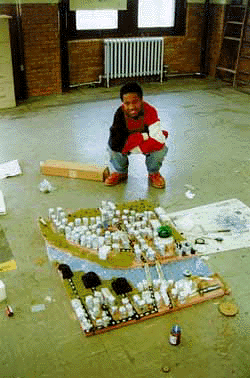 |
Fall 96
 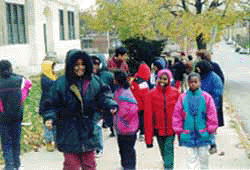
|
Transforming
the Urban Landscape In fall
1996, Professor Spirn and twenty-four graduate students
from the Landscape Architecture and Regional
Planning 601 studio "Transforming the
Urban Landscape" worked with four Sulzberger
teachers and 130 Sulzberger students: Glenn Campbell's
eighth grade; Crystal Roye's eighth grade; Mattie Lloyd's
sixth grade; and Joann Shafer's seventh grade. The whole
neighborhood was the classroom with the school at the
center. At the heart of the story was the Mill Creek, a
stream which once flowed across the field where the
school playground is now, and still does flow, buried in
a sewer which runs right past the school. Working with
teachers and students at Sulzberger, the graduate
students documented environmental and community history
as well as devising designs for the vacant land near the
school.
|
Spring 1996
|
Aspen Farm Community
Garden
|
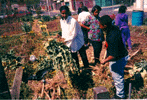 |
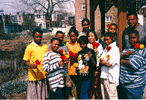 |
 |
Daisy
Century's class started a vegetable garden at Aspen Farm
Community Garden in 1996 with the help of Rachel
Sterling-Boyers and Hayward Ford. Their vegetables won
several ribbons at the Fall 1996 Harvest Show, sponsored
by the Pennsylvania Horticultural Society.
|
Fall 1995
1995 ASCE
Future City Competition
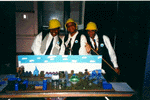
|
|
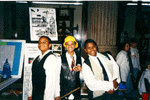
|
|
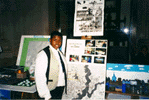
|
Students at the
January 27, 1996 competition. |
|
Students at the
January 27, 1996 competition. |
|
Students at the
January 27, 1996 competition. |
| From October 1995 to January 1996
several students participated in the 4th annual National
Engineers Week Future City Competition. Since the program
began in 1992, the purpose of the competition has been to
introduce students to engineering through practical
applications of math and science and work with engineers.
The team consisted of three students, Adam Ankrah, Nagia
Owen and Dennis Williams, assisted by Daisy Century,
Rachel Sterling-Boyers, a Penn landscape architecture
student, Laura Aibel, a licensed civil engineer and other
members of the class. They designed future cities on a
computer using Maxis' SimCity Classic) software, used a
blueprint to build a model of a section of the created
city, and finally wrote an essay
on considerations in designing a manufacturing zone. The
Sulzberger students competed in Philadelphia on Saturday,
January 27, 1996 at the Franklin Institute. |
|
